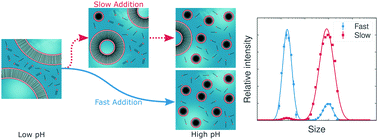Neutralisation rate controls the self-assembly of pH-sensitive surfactants†
Abstract
The degree of ionisation of a weakly acidic surfactant can be continuously modified from nonionic to ionic by adjusting the pH. This property can be used to control the curvature and therefore the morphology of the self-assembled aggregates it forms in solution. Herein, we report the surprising phenomenon, observed in the alkyl ether oligo(ethylene oxide) carboxylate (CH3(CH2)11/13OEO4.5CH2COOH), whereby it is not only the pH but also the neutralisation rate that affects the aggregate morphology. Specifically, when the pH is increased slowly, up to 40 wt% of the surfactant remains in a long-lived vesicle state at high pH. This phenomenon was characterised in detail by small-angle neutron scattering and light scattering techniques. The cause of this phenomenon is thought to be related to a combination of polydispersity and the formation of acid-carboxylate dimers close to the pKa. The transition of these vesicles to the thermodynamically favoured micelles at high pH is inhibited by a high activation energy barrier and therefore only occurs very slowly. Increasing the NaCl concentration eliminates the presence of vesicles at high pH, demonstrating that the activation energy for the vesicle-to-micelle transition depends strongly on electrostatic interactions. These experiments show that the preparation pathway can be used to obtain different self-assembled structures at identical conditions via kinetic control. This phenomenon provides a useful tool for devising formulations where the properties of the system can be altered without changing the composition.



 Please wait while we load your content...
Please wait while we load your content...